
Kochi, also known by its former name Cochin, is a major port city along the Malabar Coast of India bordering the Laccadive Sea. It is part of the district of Ernakulam in the state of Kerala. The city is also commonly referred to as Ernakulam. As of 2011, the Kochi Municipal Corporation had a population of 677,381 over an area of 94.88 km2, and the larger Kochi urban agglomeration had over 2.1 million inhabitants within an area of 440 km2, making it the largest and the most populous metropolitan area in Kerala. Kochi city is also part of the Greater Cochin development region and is classified as a Tier-II city by the Government of India. The civic body that governs the city is the Kochi Municipal Corporation, which was constituted in the year 1967, and the statutory bodies that oversee its development are the Greater Cochin Development Authority (GCDA) and the Goshree Islands Development Authority (GIDA).

The Kingdom of Cochin, also known as the Kingdom of Kochi or later as Cochin State, named after its capital in the city of Kochi (Cochin), was an Indian Hindu kingdom in the central part of present-day Kerala state. It commenced at the early part of the 12th century and continued to rule until its accession to the Dominion of India in 1949.

Travancore–Cochin, officially the United State of Travancore and Cochin and later the State of Travancore–Cochin, was a short-lived state of India. It was formed through the merger of two former kingdoms, Travancore and Cochin on 1 July 1949. Its original capital was Thiruvananthapuram.
Paliath Achan or Paliyath Achan is the name given to the oldest male member of the Paliam family, a Nair/Menon royal family from the Indian state of Kerala who ruled over Chendamangalam, Vypin, parts of Thrissur and regions that were under the erstwhile Kingdom of Villarvattom. The family had palaces and forts in these regions but their primary residence remained in Chendamangalam. The Paliath Achans were given the role of hereditary Prime ministership of the Kingdom of Cochin by the Kochi Maharajah.
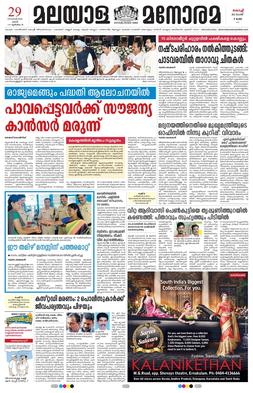
Malayala Manorama is a morning newspaper in Malayalam published from Kottayam, Kerala, India by the Malayala Manorama Company Limited. Currently headed by Mammen Mathew, it was first published as a weekly on 14 March 1888, and currently has a readership of over 8 million. It is also the second oldest Malayalam newspaper in Kerala in circulation, after Deepika, which is also published from Kottayam. Manorama also publishes an online edition.
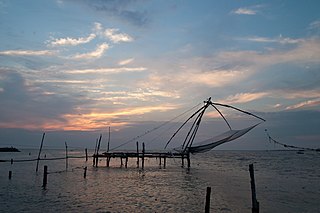
Fort Kochi, also known by its former name Fort Cochin or British Cochin is a neighbourhood of Cochin (Kochi) city in Kerala, India. Fort Kochi takes its name from the Fort Manuel of Cochin, the first European fort on Indian soil, controlled by the Portuguese East Indies. This is part of a handful of water-bound islands and islets toward the south-west of the mainland Kochi, and collectively known as Old Cochin or West Cochin. Adjacent to this is the locality of Mattancherry. In 1967, these three municipalities along with a few adjoining areas, were amalgamated to form the Kochi Municipal Corporation.

Ernakulam is the central business district of the city of Kochi, Kerala, India. It is the namesake of Ernakulam district. The eastern part of Kochi city is mainly known as Ernakulam, while the western part of it after the Venduruthy Bridge is called as Western Kochi. Many major establishments, including the Kerala High Court, the office of the Kochi Municipal Corporation and the Cochin Shipyard are situated in Ernakulam. It is also the most urbanized area in the city of Kochi.
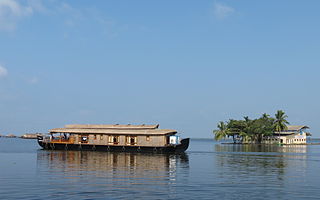
Kerala, called Keralam in Malayalam, is a state on the Malabar Coast of India. It was formed on 1 November 1956, following the passage of the States Reorganisation Act, by combining Malayalam-speaking regions of the erstwhile regions of Cochin, Malabar, South Canara, and Travancore. Spread over 38,863 km2 (15,005 sq mi), Kerala is the 21st largest Indian state by area. It is bordered by Karnataka to the north and northeast, Tamil Nadu to the east and south, and the Lakshadweep Sea to the west. With 33 million inhabitants as per the 2011 census, Kerala is the 13th-largest Indian state by population. It is divided into 14 districts with the capital being Thiruvananthapuram. Malayalam is the most widely spoken language and is also the official language of the state.

The Kochi Municipal Corporation is the municipal corporation that manages the Indian city of Kochi in the state of Kerala. The Corporation manages 94.88 km2 of Kochi city and has a population of 677,381 within that area. It is the most densely populated city corporation in the state. Kochi Municipal Corporation has been formed with functions to improve the infrastructure of town.
Kochi, formerly known as Cochin, is a city and port in the Indian state of Kerala.

Veluthedathu Muhammed Haneefa, better known by his stage name Cochin Haneefa, was an Indian actor, film director, and screenwriter. He started his career in the 1970s mainly portraying villainous roles, before going on to become one of the most popular comedians of Malayalam cinema. He acted in more than 300 films in Malayalam and Tamil.

Sree Kerala Varma College is a government aided college in Kanattukara, Thrissur, Kerala, India. Founded in 1947 by His Highness Aikya Keralam Thampuran, the Maharaja of erstwhile Kingdom of Cochin. Managed by the Cochin Devaswom Board, Sree Kerala Varma College is an academic institution in Kerala.
Siddique Ismail was an Indian film director, producer, screenwriter and actor who predominantly worked in Malayalam cinema. He made his directorial debut with the Malayalam film Ramji Rao Speaking (1989). His screenwriting debut came with the Malayalam film Pappan Priyappetta Pappan (1986). His final film was Big Brother (2020).

Kerala Varma Thampuran popularly known as Aikya Keralam Thampuran or Kerala Varma VII was the Maharaja (king) of Cochin who ruled between 1946 and 1949. He mooted the idea of a unified Kerala state in India for the Malayalam speaking population and stood for the merging of British Malabar, Cochin and Travancore. Therefore, he was given the sobriquet Ikyakeralam Thampuran. He died in July 1948. He was also the brain behind the formation of Sree Kerala Varma College at Thrissur, named after him.
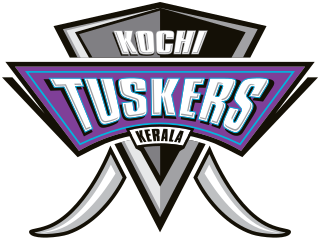
Kochi Tuskers Kerala was a franchise cricket team that played in the Indian Premier League (IPL) representing the city of Kochi, Kerala. The team was one of two new franchises added to the IPL for the 2011 season, alongside Pune Warriors India. The team franchise was owned by Kochi Cricket Pvt Ltd., which was a consortium of multiple companies.

Raveendran (Ravindher), popularly known as Disco Raveendran is an Indian actor, primarily concentrating in Malayalam and Tamil films and he was a very busy actor of both these languages in the 1980s. A multi-faceted personality, Raveendran is also a screenwriter, interior designer, anchor, a film scholar, an acting coach, social activist and director of film festivals like Kochi Metro (Malayalam) Short Film Fest. He is an alumnus of the Adayar film school, Chennai.

Pearle Maaney is an Indian actress, lyricist, YouTuber, and television presenter who works in Malayalam shows. She is known for co-hosting three seasons of the Malayalam dance reality show D 4 Dance. In 2018, Pearle emerged as the first runner-up of the Big Boss Malayalam season 1.

Cochin Carnival is an entertainment event held every year in the last week of December at Fort Kochi in the city of Kochi, Kerala. This event is held mostly during the last two weeks of December and finally ends on 1 January. It is officially inaugurated with hoisting the Indian national flag at the Vasco da Gama Square.

The city is administered by the Kochi Municipal Corporation, headed by a mayor assisted by the Secretary. For administrative purposes, the city is divided into 74 wards, from which the members of the corporation council are elected for five years. Earlier; Fort Kochi, Mattancherry and Ernakulam were the three Municipalities in Cochin area, which was later merged to form the Kochi Municipal Corporation.
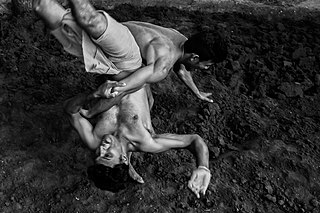
Gatta gusthi is a form of submission wrestling practiced in Kerala, India. It is competed inside an open ring on the ground, usually on a beach, known as godha. Wrestlers are called phayalvans. The sport consists of around 100 techniques. Gatta gusthi was popular in the state until the arrival of freestyle wrestling and karate in late 1960s. Its freestyle form is known simply as gusthi.


















